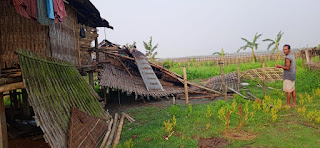MONOJ GOGOI DHEMAJI, MAY 2: Kalbari an archipelago swathe of countryside in the Subansiri river under Bihpuria revenue circle of Lakhimapur district largely devastated by a massive storm came yesterday evening from the southern side and later the reversed storm wind flattened a large number of houses in the village with 85 households. Raj Kumar Chandi, a resident of the village and volunteer of People's Action for Development (PAD) informed today that the storm came suddenly and flattened 15 houses in village and the rest of the houses had been damaged highly by eroding roofs and bamboo walls. Elderly people told that this was an unprecedented storm and never experienced in their lifetimes. The panic stricken people immediately took shelter under banana trees available in the village with their children only to save to save lives. People from the village also informed that including houses they also lost their rice banks to the storm. When the storm ended it became dark and people spent the night in an Anganwari centre - concrete house. The people of Kalbari who belongs to the Mishing community usually lives in stilted house but today they are preparing to spend the night on ground by making temporary home with corrugated tin-sheets and tarpaulins. Raj Kumar Chandi, who also lost his house told that high intensive storm ravaged the standing crops of the village and created problem to the livestock too. The village people alleged that till this evening no government official either from the Circle office of Bihpuria or from District Disaster Management Authority (DDMA) of Lakhimapur visited the village to assess the damages caused by the storm. Philipson Sona, Deputy Director of an well known NGO, Peoples' Action for Development (PAD) told that a team of his organization would visit the village tomorrow and would be tried to assist the storm victims.
MONOJ GOGOI The 2000 MW Subansiri Lower Hydroelectric Project which construction work is undergoing at Gerukamukh ( the project site) in the West Siang of Arunachal Pradesh and Dhemaji districts Assam will be commissioned by December 2024. This was recently revealed to the media by Rajeev Kumar Vishnoi, Chairman and Managing Director (CMD) of National Hydroelectric Power Corporation (NHPC) Ltd. All the eight units, comprising 250 MW each will be commissioned by the end of 2024. This one is one of the major projects of NHPC Ltd and after completion it will add 4 percent to the total hydro power generation of India. A file photo of the project site. Earlier several deadlines were set to complete the project but each time it failed for several reasons. If the project is finished by the end of 2024, it would take more than two decades in developing the project. Due to time overrun cost overrun also took place. The estimated cost of the project Rs 21,274....

















Comments
Post a Comment